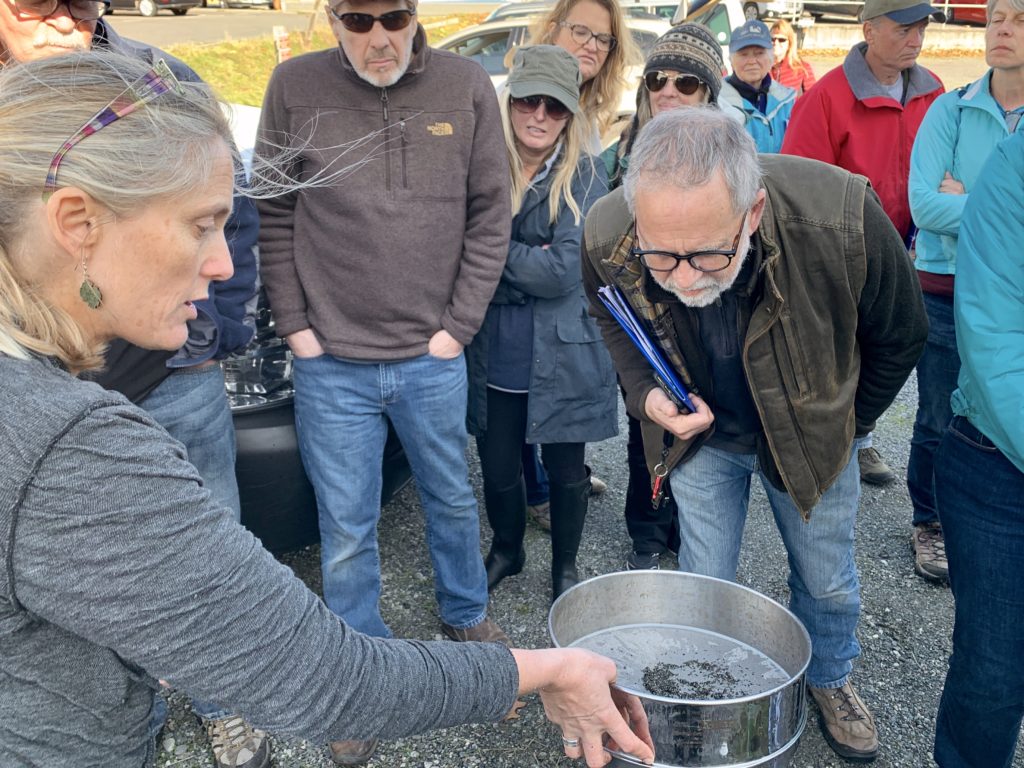Friends of the San Juans recently completed a multi-year research project for a particular species of forage fish: the Pacific sand lance. Forage fish are an essential player in the Salish Sea marine food web as prey for salmon, rockfish, seabirds, and other marine mammals. Sand lance are especially important in the diet of juvenile salmon as they are often the first fish they can eat.
Spanning over the course of four winters, our research project more than doubled the number of known Pacific sand lance spawning sites in San Juan County, and also increased the number of surf smelt spawning beaches. Research results improve our understanding of where these important fish spawn and leads to the enhanced protection and restoration of shoreline habitat in San Juan County, supporting salmon recovery.

Pacific sand lance are a dominant forage fish in our region, yet broader knowledge of where they lay their eggs in San Juan County was limited. Researching these forage fish is challenging because sand lance spawn in the winter when low tides occur mostly at night, not to mention the less than hospital weather conditions for boat-based field work.
As intertidal beach spawners, sand lance are especially vulnerable to the impacts of shoreline modifications. Documented spawning sites receive greater local and state regulatory protections. Understanding where forage fish spawn also informs voluntary salmon recovery efforts such as shoreline conservation easements and restoration projects.
Thanks to our project partners, each winter from 2018 through 2022 our research team gathered a total of 1,000 samples of sand for lab analysis of forage fish eggs. Samples came from a total of 175 sites throughout 13 local islands. Friends team was supported by trained community science volunteers and students from 6 islands, providing 900 hours of field survey collection assistance. Over 275 students from Orcas Island High School, Spring Street International School, Waldron School, and Decatur School received training and participated in field surveys on their respective islands.






Because of their engagement in this project, hundreds of youth, shoreline property owners, and community science volunteers have an improved understanding of marine food webs and the importance of intact beach habitats and coastal processes.
Research results of Friends of the San Juans forage fish spawn habitat research project:
- There are now 13 miles of documented forage fish beaches in San Juan County, which accounts for about 8% of the ‘soft’ or non-bedrock shorelines.
- We found 12 new sand lance sites, more than doubling the known number of sand lance sites from 9 to 21.
- New sand lance sites were documented on Orcas, San Juan, Lopez, and Waldron Islands.
- Additionally, 9 new surf-smelt spawning beaches were documented on San Juan, Henry, Lopez, and Shaw Islands, and two previously recorded surf-smelt spawning sites on Lopez and Shaw islands were expanded.
Results in action:
- A vastly improved understanding and associated regulatory protections for pacific sand lance spawning sites in San Juan county. The resulting research supports the recovery of Chinook salmon and critically engaged southern resident killer whales by supporting marine food webs.
- Project results have been compiled with past data for all forage fish habitat utilization in San Juan County to get a broader picture of the important role these fish play in Salish Sea marine food web
- Project geodatabases and maps are being provided to local and state land managers including but not limited to San Juan County (SJC), Washington Department of Fish and Wildlife (WDFW), the San Juan County Land Bank, and the San Juan Preservation Trust (SJPT).
- Information on the 12 new Pacific sand lance and 9 new and 2 expanded smelt spawning sites is already being applied to voluntary protection and restoration efforts including preserve management plans, conservation easements and plans to remove unnecessary shoreline modifications to restore beach habitat.
The following map illustrates all of the known forage fish spawning in in San Juan County, including the beach spawning Pacific sand lance and surf smelt as well as Pacific herring, which spawn just offshore on submerged aquatic vegetation. It represents nearly three decades of research, combing data from the recently completed Friends forage fish spawn habitat project, as well as previous Friends of the San Juans and Washington Department of Fish and Wildlife efforts.

Partners in Friends’ forage fish spawn habitat research project include Dan Penttila of Salish Sea Biological who conducted lab analysis of samples, the Samish Indian Nation’s Natural Resources Department who provided winter boat support, and hundreds of shoreline landowners who provided access for research. The project is conducted in collaboration with the Washington Department of Fish and Wildlife (WDFW), who maintains the state-wide forage fish spawn habitat maps with funding support from the Washington State Salmon Recovery Funding Board, WDFW’s Aquatic Lands Enhancement Account, The Wheeler Foundation, and Friends members.
